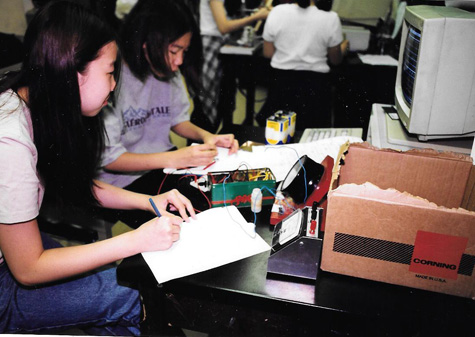Lab 6: --Ohm's Law Lab

Problem: What is the relationship between current, and resistance when there is a constant voltage in an electric circuit.
Materials: Voltmeter, Ammeter, 5 resistors,light bulb, wire, power source.
Procedure:
1) Copy Table I. And Table II into you lab notebook.
2) Assemble the circuit as shown in class. Leave the end clips to insert the various resistors.
3) Measure each resistor with the ohmeter. Do not change the dial. Keep the dial set to ohms (W) . Put each resistor on a piece of paper and label each resistor.
4) Insert the 1000 ohm resistor in the circuit.
5) Have your teacher check your circuit. Turn on the switch to power the 1 volt battery. Read the current on the ammeter. Record the current in table I (see results section). Unclip the 1000 ohm resistor and insert 1500 ohms and repeat. Continue increasing the resistance. For values you do not have you will have to combine two or three resistors in series.
If time permits....
6) Measure the resistance of a light bulb turned off.
7) Put the light bulb into the circuit in place of a resistor. When the light bulb is turned on record the voltage and current in the circuit. Use ohms law to calculate the resistance of the light bulb when turned on.
Results:
Table I.
V= 1.5 volts
Currents (amps) Resistance (Amps)
________ 1000
________ 1500
________ 2000
________ 3000
________ 5000
Table II.
V= 3.0 volts
Currents (amps) Resistance (Amps)
________ 1000
________ 1500
________ 2000
________ 3000
________ 5000
Graphs: Plot your data from Table I and Table II on the same axis. Label the x-axis resistance (ohms) and the y-axis current (ma- milliamperes)
Discussion:
1) What are the independent and dependent variables?
2) How are the variables changing with relationship to each other?
3) What happens to the dependent variable when the independent variable increases? decreases?
4) How does the relationship shown in this experiment compare with other relationships you have so far seen?
5) How does the equation for this relationship compare with those of other equations you have studied?
6) What is the equation for ohms law? How does this relate to your graph.
Applications:
1) Explain how a light dimmer works.
2) How does a fuse work?
3) If instead of keeping the voltage constant you kept the resistance constant, then plotted voltage vs current, what shape graph would you get? What would the slope of the graph be?
4) If you measured the resistance of the light bulb explain the difference when the bulb was off and on. How does this affect the efficiency in an electric circuit?
Lab Activities and Resources
What are Mathematical Relationships
What is a mathematical relationship and WHAT ARE THE DIFFERENT TYPES OF MATHEMATICAL RELATIONSHIPS that apply to the laboratory exercises in the following activities.
Labs
Lab 1: The Spring Constant -- Problem: What is the relationship between how much a spring stretches and the force pulling on the spring?
Lab 2: The Pendulum --Problem: What is the relationship between the period of a pendulum and the length of the string of the pendulum?
Lab 3: Mass, Volume and Density-- Problem: What is the relationship between the mass of a ball and its volume assuming a constant density?
Lab 4: Light Intensity-- Problem: What is the relationship between the intensity of a beam of light and the distance from a light source?
Lab 5: Acceleration-- Problem: What is a the relationship between how the distance travels and the time in travel for an accelerating object?
Lab 6: Polarization -- Problem: What is the relationship between how much light passes through a Polaroid filter and the angle the filter is rotated?
Lab 7: Ohms Law-- Problem: What is the relationship between current, voltage when there is a constant resistance in an electric circuit.
Lab 8: Radioactive Decay-- Problem: What is the relationship between the decay of radioactive material and the time allowed for the decay?
Lab 9: Water Pressure-- Problem: What is the relationship between water pressure and depth of water?
Lab 10: Attractive and Repulsive Forces-- Problem: What is the relationship between the distance between two magnets and the force between them?
Lab 11: Damping Motion-- Problem: What is the relationship between the height a ball bounces and the number of times it has bounced?
Lab 12: Buoyancy - Problem: What is the relationship between the volume of a boat and the weight it can hold?